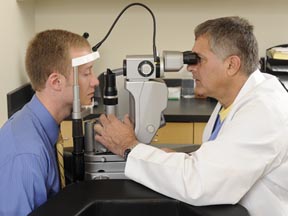Do you get your eyes checked regularly? You should, say ophthalmologists at the University of Alabama at Birmingham’s Callahan Eye Hospital. By age 65, one in three Americans will have a vision-impairing eye disease, according to the American Academy of Ophthalmology.
 Common eye diseases such as glaucoma, diabetic retinopathy, uveitis and age-related macular degeneration threaten the eyesight of millions of Americans, potentially robbing them of vision, mobility and independence.
Common eye diseases such as glaucoma, diabetic retinopathy, uveitis and age-related macular degeneration threaten the eyesight of millions of Americans, potentially robbing them of vision, mobility and independence.
“The good news is that researchers at UAB and around the nation are making new discoveries that are yielding sight-saving treatments,” said Chris Girkin, M.D., chair of the UAB School of Medicine’s Department of Ophthalmology. “But early diagnosis, timely treatment and appropriate follow-up care are essential to preventing irreversible vision loss.”
Healthy Vision Month is a national eye health observance established by the National Eye Institute in May 2003. During Healthy Vision Month, NEI and UAB are stressing the importance of early diagnosis and treatment.
Early stages of common eye diseases typically have no symptoms and can only be detected through a comprehensive dilated eye exam. Pupil dilation allows a doctor to closely examine the back of the eye for signs of eye disease.
“We have therapies to minimize the effects and slow down the progression of diseases such as glaucoma and macular degeneration, but to be effective, we need to begin those therapies early in the course of the disease,” said Girkin.
Girkin recommends that young adults have a complete exam by an eye-care professional once in their 20s and twice in their 30s. However, people who wear contacts should be seen annually. Those who have diabetes or a family history of eye disease should talk to their ophthalmologist about how frequently they should be examined.
Since the early signs of many eye diseases begin in midlife, Girkin recommends a baseline comprehensive eye exam at age 40, with the frequency of follow up exams determined by family history and the results of the baseline exam.
After age 65, Girkin says yearly exams are essential to check for age-related eye diseases such as macular degeneration, diabetic retinopathy, glaucoma, cataract and other eye conditions.
Glaucoma causes damage to the optic nerve, which relays visual information from the retina to the brain. It is the second-leading cause of blindness after cataracts and the leading cause for blindness in African-Americans. Mexican-Americans and anyone over 60, especially people with a family history of the disease, also are at increased risk.
Diabetic retinopathy is a complication of diabetes causing swelling, leakage and blockage of the blood vessels that nourish the retina. People at risk of diabetic retinopathy include people with Type 1 or Type 2 diabetes.
Age-related macular degeneration occurs when cells in the center part of the retina, called the macula, break down. People ages 50 and older, whites, smokers and those with a family history of AMD are at greater risk of developing the disease.
Uveitis is swelling and irritation of the uvea, the middle layer of the eye. It often is associated with autoimmune diseases but can occur in otherwise healthy people.
UAB’s ophthalmologists, based at the UAB Callahan Eye Hospital, offer other unique eye care services, including low vision rehabilitation, a driving assessment clinic and clinical research studies. The Callahan Eye Hospital has 24-hour emergency eye care and is the nation’s first Level I ocular trauma center as designated by the American Society of Ocular Trauma.
To find a UAB ophthalmologist, go to www.uab.edu/eyedoc or call 205-325-8620.
